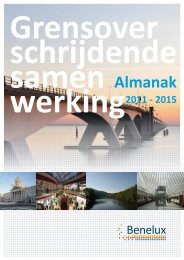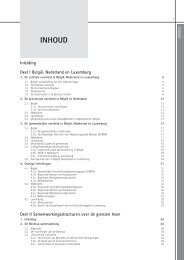The North Seas Countries' Offshore Grid Initiative - Initial ... - Benelux
The North Seas Countries' Offshore Grid Initiative - Initial ... - Benelux
The North Seas Countries' Offshore Grid Initiative - Initial ... - Benelux
You also want an ePaper? Increase the reach of your titles
YUMPU automatically turns print PDFs into web optimized ePapers that Google loves.
facilities using other primary resources do. Investment decisions therefore need to be<br />
made for the long term and should be thoroughly prepared and planned. <strong>The</strong> conceptual<br />
offshore grid designs contained in this report are intended to prepare the market and<br />
decision makers for the possible future grid development that could be needed between<br />
now and 2030.<br />
<strong>The</strong> grid designs should potentially contribute to identify and potentially mitigate<br />
bottlenecks in the onshore grid system and facilitate the greater integration of electricity<br />
markets in the region. <strong>The</strong> grid designs take account of the envisioned developments in<br />
new technology and make assumptions on the price of technology as elaborated in [5].<br />
<strong>The</strong> generation and load assumptions for the Reference scenario were based on the EU’s<br />
latest available PRIMES scenario, which were adapted by each Government to present their<br />
best view on 2030. This status of best views was collected in summer 2011 and so may<br />
have changed since then.<br />
In general it makes a difference if a scenario is based on collected national information or<br />
on a modelled vision based on an implicit consistent European policy, which might even<br />
include an investment model for electricity production facilities. In a collected scenario the<br />
different countries might take different decisions for reaching a similar target – or even<br />
the different national targets. Although each national contribution may be the result of<br />
sophisticated government modelling, it is always hard to estimate the neighbours’<br />
decisions and behaviour due to lack of information.<br />
Associated technical characteristics was added to the collected national data and<br />
processed in the TSO’s various models.<br />
1.1.5 Stepwise development of an offshore grid<br />
<strong>The</strong> future-looking assessment of the possible developments of an offshore grid is based<br />
on a number of principles that impact the electricity system designs included in this<br />
document.<br />
In its publication on the <strong>North</strong> <strong>Seas</strong> <strong>Grid</strong> development in February 2011 3 ENTSO-E assumed<br />
that the pattern of offshore grid development would follow interim steps, under which<br />
current radial approaches would be followed by concentration patterns (‘local<br />
coordination’ and ‘international coordination’) before (fully) meshed designs were<br />
adopted, Figure 1-3. This same evolution of an offshore grid is also assumed in this<br />
report.<br />
3<br />
ENTSO-E: <strong>Offshore</strong> <strong>Grid</strong> Development in the <strong>North</strong> Sea - ENTSO-E views – Feb 2011<br />
https://www.entsoe.eu/fileadmin/user_upload/_library/position_papers/110202_NSOG_ENTSO-<br />
E_Views.pdf<br />
Page 7 of 142










